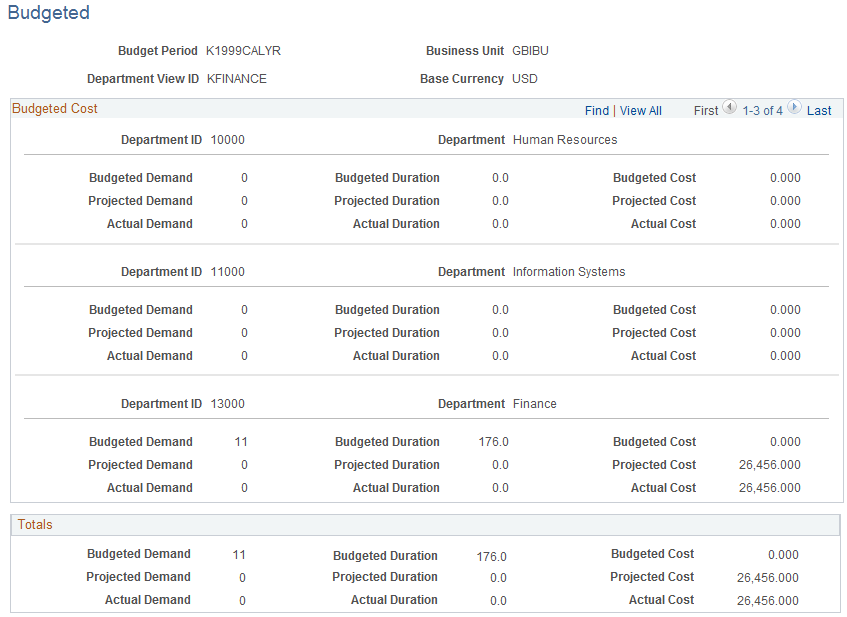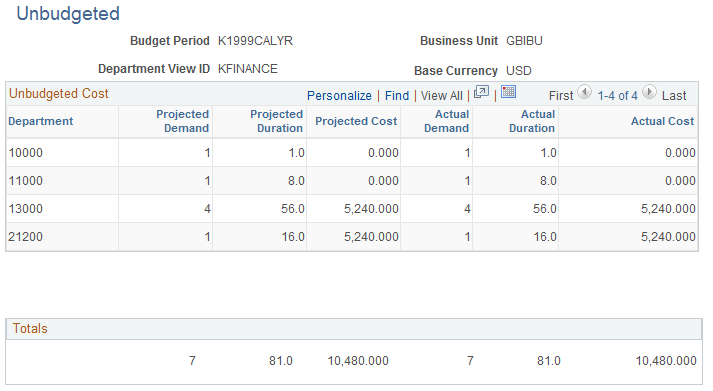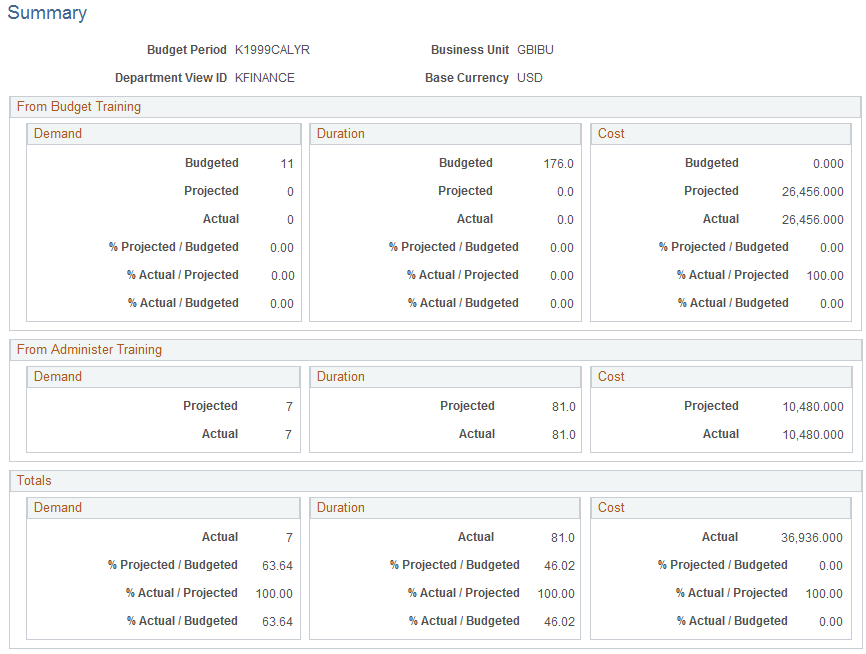Reviewing Training Costs
These topics discuss how to review training costs.
|
Page Name |
Definition Name |
Usage |
|---|---|---|
|
TRN_BDGT_ACT_COST |
Review budgeted costs compared to actual training costs. |
|
|
TRN_NOTBDGT_COST |
Review current unbudgeted training costs. Costs can include projected costs without any actual expenditure, if you have not spent the projected amount. |
|
|
TRN_CMPSUMMRY_COST |
Compare budgeted and actual training cost totals. |
Use the Budgeted page (TRN_BDGT_ACT_COST) to review budgeted costs compared to actual training costs.
Navigation:
This example illustrates the fields and controls on the Budgeted page. You can find definitions for the fields and controls later on this page.

Note: In the departmental view, to see all the budgeted training versus the current training information for all departments, you may need to scroll down the page.
Use the Unbudgeted page (TRN_NOTBDGT_COST) to review current unbudgeted training costs.
Costs can include projected costs without any actual expenditure, if you have not spent the projected amount.
Navigation:
This example illustrates the fields and controls on the Unbudgeted page. You can find definitions for the fields and controls later on this page.

Use the Summary page (TRN_CMPSUMMRY_COST) to compare budgeted and actual training cost totals.
Navigation:
This example illustrates the fields and controls on the Summary page. You can find definitions for the fields and controls later on this page.

From Budget Training
These results include all the demands that you budgeted for in the Budget Training business process.
For all of the budgeted training costs for the specified budget period, business unit, and departments in the departmental view ID), the system provides demand, duration and cost information as follows:
|
Category |
Demand |
Duration |
Cost |
|---|---|---|---|
|
Budgeted |
Budgeted total demand (number of employees to be trained). |
Budgeted total training duration that you estimated as part of the training budget. |
Total budgeted training cost. |
|
Projected |
Projected (current realized) training demand (number of employees that are enrolled or are in training). |
Projected (current realized) duration for the training that has occurred to date. |
Projected cost for the training to date. The projected amounts here include those students that have been enrolled in the course sessions for that budget period, including those who have completed the course. |
|
Percent of projected (realized) cost compared to budgeted cost |
Projected (realized) demand compared to budgeted demand. |
Projected (realized) duration compared to budgeted duration |
Projected cost compared to budgeted cost. This represents the budget percentage you've projected that you will spend to date. Remember that you haven't actually spent this money yet, because it is only projected. |
|
Actual training expenses incurred to date |
Actual number of employees trained (demand). |
Actual total training duration to date. |
Actual cost to date. |
|
Percentage of actual costs compared to projected costs |
Actual number of employees trained compared to projected number of employees trained. |
Actual duration amount compared to projected training duration amount. |
Actual training cost compared to projected training cost. If the amount is 100 percent, then the projected budget amount equals the actual amount that you've spent. If the result is less than 100 percent, you still have projected budget money to spend. If the amount is more than 100 percent, then you've overspent the training budget. |
|
Percentage of actual cost compared to budgeted cost |
Actual (realized) demand compared to budgeted demand. |
Actual (realized) duration compared to budgeted duration. |
Actual (realized) cost compared to budgeted cost. This represents the percentage of the budget that you've spent to date. |
From Administer Training
These amounts are for costs that were not included as part of the training budget for the budget period. This includes all training that was tracked in the Administer Training business process but not linked to a budget training demand, as follows:
|
Category |
Demand |
Duration |
Cost |
|---|---|---|---|
|
Projected |
Projected (current realized) training demand (number of employees that are enrolled or are in training). |
Projected (current realized) duration for the training that has occurred to date. |
Projected cost for the training to date. The projected amounts here include those students that have been enrolled in the course sessions for that budget period, including those that have completed the course. |
|
Actual |
Actual unbudgeted employees trained. |
Actual unbudgeted training duration amount. |
Actual cost associated with training unbudgeted employees. The actual population is made up of students that have completed the course sessions for that budget period (Attendance status is Completed). |
Total Actual Costs
These amounts represent a summary of the actual costs, both as part of the training budget and from unbudgeted costs that are tracked in the Administer Training business process, as follows:
|
Category |
Demand |
Duration |
Cost |
|---|---|---|---|
|
Total actual |
Total (current realized) training demand (number of employees currently trained or in training. |
Total (current realized) duration for the training that has occurred to date. |
Total cost for the training to date. |
|
Percentage of total budgeted amount that the projected amount represents |
Percentage of total budgeted demand the projected demand represents. |
Percentage of total budgeted duration the projected duration represents. |
Percentage of the total budgeted cost that the projected cost represents. The projected amounts here include students who have been enrolled in the course sessions for that budget period but have not yet completed the course (Attendance status is other than Completed). |
|
Percentage of the total actual amount represented by the total projected amount |
Percentage of the total actual demand represented by the total projected demand. |
Percentage of the total actual duration represented by the total projected duration |
Percentage of the total actual cost represented by the total projected cost. The projected amounts here include those students that have been enrolled in the course sessions for that budget period but have not yet completed the course (Attendance status is other than Completed). |
|
Percentage of total budgeted amount that the actual amount represents |
Percentage of total budgeted demand that the actual demand represents. |
Percentage of total budgeted duration that the actual duration represents. |
Percentage of the total budgeted cost that the actual cost represents. |